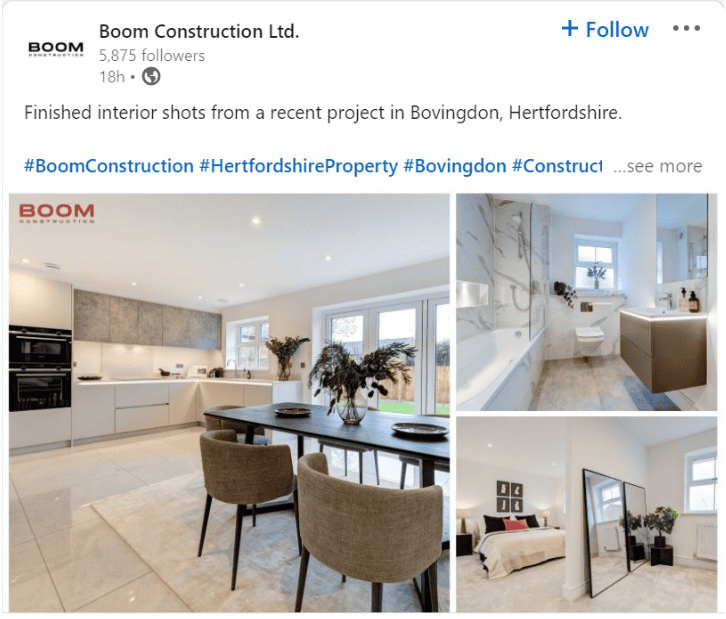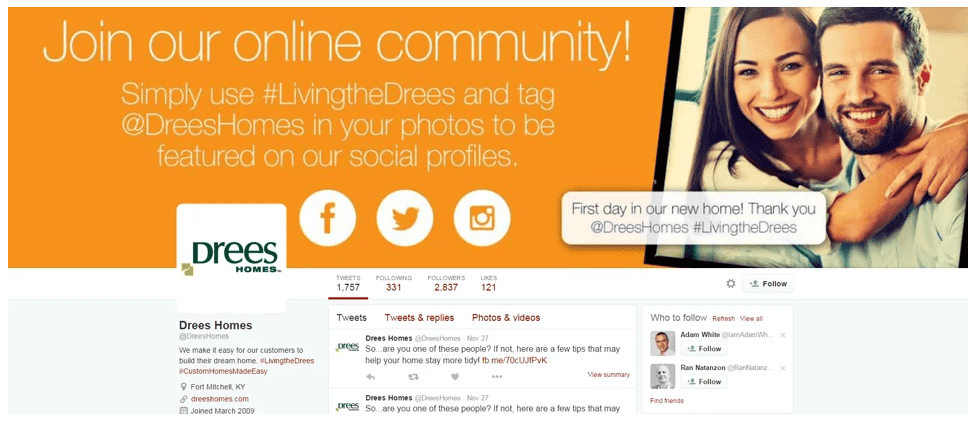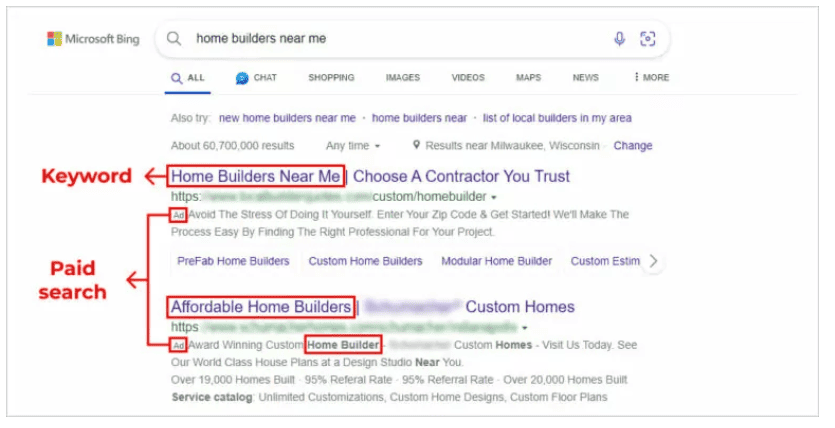Marketers in the home building sector may have discovered that attracting new clients is easier said than done. Marketing strategies for home builders have to persuade buyers to purchase what is often the biggest investment they will ever make.
Forecasts indicate that the international home-builder industry will expand from its 2022 valuation of $5,267 billion to $8,308 billion by 2032. It grows at a compound annual growth rate (CAGR) of 4.8%.
Your marketing plan should inform all aspects of your business if you want to establish a name for yourself in this massive industry. Results of strong marketing strategies for home builders include:
- An uptick in client leads
- An improvement in sales conversion rates
- A boost to the company’s image
Home builders often ask: “How much money should I put into advertising?” or “How can I create an effective marketing strategy?”
In this blog post, we discuss 8 of the best digital marketing strategies for home builders and traditional real estate development marketing methods. Take notes as you read along about what fits your brand’s budget and needs.
Table of Contents
Branding for Home Builder’s Market
An effective marketing strategy’s cornerstone is establishing a strong brand identity. A trustworthy brand distinguishes builders from competitors and relies on establishing an emotional connection with consumers.
To do that, you need a strong understanding of the target audience. Therefore, before we get into marketing strategies for home builders, it’s important to understand your target audience. You want to get to the core of:
- Their needs
- Their preferences
- Their values
This information helps home builders curate a strong brand message with visuals that speak to potential buyers. To create a thorough profile of the target audience, you’ll have to find valuable insights about their expectations and perceptions. How can you do that?
- Conduct market research
- Send out surveys
- Participate in focus groups
Consider creating an ideal customer profile (ICP) to find and target the right customers. You may get free downloadable ideal customer profile templates to get started on what information you need to collect. Customize the sections for your business and fill in data to build your ICP instantly.
As you strategize crafting your brand identity, consider these current trends and consumer preferences in the housing market:
- Rise of the sharing economy: Home-sharing and renting have been on the rise, which may have far-reaching consequences for the housing market in the future.
- COVID-19 made home offices desirable: Due to COVID-19, 13% of homebuyers altered one or more key property components. Backyards and parks are becoming more popular as Zoom meetings have changed the standard for privacy, and home offices have surged in demand.
- Houses in the suburbs are in demand: Suburban zip codes show a 13% increase in property searches, perhaps due to individuals escaping costly urban living situations.
- Millennials are the biggest buyers: A bigger share of homebuyers now belong to the younger Millennial generation (11% vs. 7% of the Silent Generation).
- They’re buying houses sooner: The housing market recovered quickly after the pandemic because of low mortgage rates, making houses more accessible. 41% of survey respondents said they expect to purchase homes sooner than expected.
- Need for more space and amenities: Post-pandemic time spent at home is more than before. Home purchasers recognize the necessity for space as many companies enable employees to work from home. Buyers require more space and facilities to accommodate everyone, as homes are now office spaces, schools, daycares, and gyms.
Consider these trends as you define your unique selling proposition (USP). It could be anything, such as:
- Creative designs
- Luxurious living
- Affordability meeting needs
- First-rate customer service
- High-quality workmanship
Whatever it is, having a distinct USP allows builders to stand out and convey their worth to prospective customers.
Some additional tips for creating a strong brand identity
Tip 1: Maintain consistency in your branding message. Create visuals that adhere to your brand image. It increases recognition and builds trust in the brand by fostering familiarity.
Tip 2: Develop brand guidelines that define your brand’s colors, imagery, and fonts that you use in your marketing content.
Tip 3: Incorporate stories that tell your brand’s history and values. You can narrate a mission behind your brand that resonates with your target audience’s preferences to develop an emotional connection.
Tip 4: Target those likely to pledge brand loyalty when you deliver promises. Aim to build a community among buyers that leads to repeat business. You can rely on them to be your brand’s spokesperson, an invaluable asset for home builders with a growing customer base.
Read also: Draft the Perfect Real Estate Drip Campaigns [Templates, Examples]
Our Top 8 Digital Marketing Strategies for Home Builders
You now understand how to brand your business for home builders’ target audience. Let’s explore digital marketing strategies for home builders to help you get started on some marketing ideas:
1. Optimize your website for search engines with SEO
People increasingly use Google and other search engines to locate local home builder companies when looking for houses and new building projects.
Every month, 1.7 million people look for independent contractors online. The “near me” search increased 500 times in the past few years.
SEO focuses on increasing your site’s visibility in search engines like Google. A higher ranking means more visitors to your site. Your conversion rate is directly proportional to the traffic you receive. Having your website rank on top of search engines is a big win in marketing strategies for home builders.
Creating content per recommended SEO standards entails a great deal, including:
- Using keywords
- Adding meta tags
- Publishing content consistently
- Adding internal and outbound links
- Optimizing your website speed
- Getting a Secure Sockets Layer (SSL) certificate
To target local SEO, you can consider the following:
- Sign up with Google My Business to show up when someone looks for home builders in your locality.
- Start a blog and target local high-ranking keywords like “your state name + new home builders.”
- Use local keywords to (alt) text while optimizing images.

Tools to rely on
- Google Analytics: Instal the tool on your website to track visitors and see how well your SEO strategy performs.
- Ahrefs’ Keyword Explorer: Use the keyword research tool to get keyword ideas from a huge database with monthly search volumes and other metrics.
2. Build a social media presence
Social media is a powerful marketing tool for all businesses, and we can’t miss out on it in our marketing strategies for home builders.
Social media is a great platform to gain visibility; however, it’s difficult to conquer. Each platform has its unique characteristics and audience demographics, and they can serve different purposes, such as:
- Facebook (varied range of demographics) is great for:
- Reaching a wide range of demographics
- Building brand awareness
- Engaging with potential clients through comments and messages
- Showcasing their projects through photo albums
- Instagram (visual platform) is great for:
- Showcasing aesthetics and quality through high-quality images and videos
- Leveraging stories and reels for behind-the-scenes content
- Highlighting the construction process
- Showcasing finished projects
- Gaining visibility through hashtags
- LinkedIn (networking platform) is great for:
- B2B marketing
- Connecting with suppliers, contractors, and industry professionals
- Establishing expertise in the field through content
- X (formerly known as Twitter) is great for:
- Sharing quick updates
- Engaging with customers through tweets
- Participating in relevant industry conversations
- Pinterest (a highly visual platform) is great for:
- Showcasing home designs, plans, and interior decor ideas
- Reaching potential clients who are looking for inspiration for their homes
- YouTube (video-sharing platform) is great for:
- Showcasing projects through videos
- Sharing client testimonials
- Offering educational content about home-building processes and tips
It’s important to curate content based on the platform’s requirements. To help you get started with content for social media, here are some tips with great examples:
- Create posts that are engaging. You may ask questions or poll your followers to get them to interact with your brand.
For example, take a look at this Instagram post from LennarHomes:

This post garnered more than 2K viewers. The secret? It calls for engagement with the question: “What space in this beautiful home do you like the most?”
- Build your credibility on LinkedIn by building a network of professionals. Post content that helps you stand out as an industry leader.
Take a look at this post from Boom Construction Ltd. that showcases its finished project:

- Build a community by responding to people who comment on your posts. Get personal to build a relationship.
Here’s how Pulte Homes uses this strategy to stay in touch with their target audience on Facebook:

- Use social media platforms as a portfolio builder. Pinterest is a great spot to share pictures people can save for future reference.
Here’s a stunning showcase from ArchDaily, one of the most popular architecture websites:
With over 750K followers, many Pinterest users look to ArchDaily’s designs for inspiration.
- Create short videos on a specific subject that may interest the viewer to watch until the end, say a did you know or DIY?
For example, here’s a video with 4 million views on YouTube that teaches how to grout:

- Hashtags are an excellent way for people to discover you via relevant keywords. Use them, but be careful not to clutter your posts with unnecessary ones. Do your research to find the trending ones that match your content on a specific platform.
Drees Homes shows their inventiveness in hashtag invention and dedication to brand engagement by allowing anybody who interacts with it to tag #LivingTheDrees. During the holidays, Drees Homes keeps its hashtags topical and exciting with regular maintenance, such as #HappyHollyDrees.

Tools to rely on
- Loomly: All-rounder social media management automating application.
- Buffer: A mobile content scheduling app for all social media platforms.
- ritetag.com: A hashtag tool that displays tweets, retweets, and views for certain hashtags on X.
3. Make it to your lead’s inbox with email marketing campaigns
Email marketing is a must-have tool as part of the marketing strategies for home builders. It can help:
- Reach potential buyers
- Announce available listings
- Encourage them to put down deposits on houses in neighborhoods they’re interested in
If you want to increase the number of bookings for custom houses you build, email marketing with segmentation lets you send targeted marketing emails. When you have a CRM with robust contact management, like EngageBay, it can allow you to capture and segment your target audience based on specific characteristics, such as:
- Demographics
- Preferences
- Online behavior
- Interests and more
You may use these segments to deliver personalized email content that meets your lead’s needs. Data shows that compared to unsegmented emails, segmented ones get 30% higher opens and 50% more clickthroughs.
Segmentation and personalization of email content will keep your home-building services in the minds of your prospects. It will encourage them to consult with you when they are ready.
You can also leverage email marketing automation with a cloud-based CRM. You may set triggers to send emails to specific leads when they take certain actions. For example, automate an email with details for someone who showed interest in your business:

Tools to rely on
- EngageBay email templates: Get easy-to-customize email templates for different occasions.
- EngageBay email marketing platform: Use templates to create and automate your email campaigns in a few clicks.
4. Content is king (when you do it right)
Every marketer will swear by the power of content. Relevant content helps brands build trust and establish authority, so we can’t ignore it in our home builder marketing strategies.
In fact, In 2021, content marketing succeeded for 91% of marketing professionals surveyed by Semrush.
A regularly maintained blog is an excellent approach to provide search engines with the kind of content they love: new, high-quality stuff.
Posting high-quality articles on your website also shows your leads and customers that you’re the master of your domain. But what defines high-quality content? One that is:
- Relevant to the specific demographics
- Informative and educative
- Adds value to a given topic
Remember to target specific keywords for optimization to take your chances of ranking on top of search engine result pages.
A good tip: Find out what content your audience looks for the most. You’re likely to find your competitors posting about it. Include that content but add a unique twist to it by either diving in deep or adding additional things to consider.
A better tip: Niche down your target audience and personalize your content to an audience close to home. You may read a lot about “How to find the best deals on houses,” but not enough about “How to find the best deals on houses in Denver.”
The best tip: Explore related ideas to help your target audience gather means to purchase a house from you. Targeting people may need funding– whip up a blog on great loans they can rely on. Use tools to explore top-performing related content ideas in your industry, like Semrush:

The Spruce’s website content is a great example if you’re looking for some inspiration for great blogging content:
Tools to rely on
- Semrush Topic Research tool: Get a list of trending content ideas with related subtopics in a given locality.
- ChatGPT: Leverage AI to generate content ideas and structures for your written content.
5. Leverage visual marketing tools
The brain processes visuals 60,000 times quicker than text. Image-rich articles attract 94% more views. These statistics demonstrate the importance of visuals for home builders digital marketing. So, yes, any web material benefits from visuals. However, brands in the home-building sector especially need them.
Why? Because they can help your audience visualize what living in a space you built is like. They give your leads a taste of your products and services.
In addition to some high-quality images of your homes, you may utilize easily available local photos to showcase the communities. Your potential customers may enjoy the view of their future communities, such as:
- Retail centers
- Trails and parks
- Schools and more
However, remember that low-quality images or poorly filmed videos might turn off a potential customer. A primary focus should be on visuals that really wow. You may incorporate:
- Infographics
- Charts and graphs
- Floor plans
- Interactive carousels of professionally clicked photos
- Locality maps
- Long and short-form videos for virtual tours
- Drone footage of your properties
- Live streams and more
View the video content made by 4G Design Build for different topics on their website:

Tools to rely on
- Bannersnack: An online tool to create banners with various templates.
- Canva: An easy-to-use tool for creating stunning visuals with a huge stock library of countless graphics and templates to create videos, images, infographics, and more.
6. Build social proof with customer testimonials and referrals
When someone is unsure about a crucial issue, social proof may be a compelling reason to decide. Research done online is the starting point for 87% of purchasing choices, and the typical buyer reads ten reviews before deciding on a purchase.
For the community of buyers that home-builders target, there are two ways to build social proof:
- Offline: Through word of mouth and recommendations from trusted individuals, such as friends and family.
- Online: Nothing beats the power of positive reviews left by happy clients.
You may flaunt the success stories of your happy customers on your social media, website, and review websites using:
- Video testimonials
- Happy customers’ quotes
- Great storytelling
Check out this example of building social proof by Pillar Homes on social media. They get their current and former customers to leave a review on Facebook:

Tools to rely on
- Survicate: Gather customer feedback on various digital platforms via surveys that you may send as an email, attach a link, or send a message on chat.
- Google Forms: Google’s easy-to-use form builder allows you to ask various questions to collect responses regarding your customers’ experience.
7. Incorporate paid advertising in marketing strategies for home builders
The above digital marketing strategies help you attract organic traffic. However, we strongly suggest incorporating paid advertisement in marketing strategies for home builders to gain momentum.
There are a few types of ads you can consider investing in:
Paid search or paid-per-click (PPC) advertising
Paid search or paid-per-click (PPC) advertising is a powerful tool for attracting qualified visitors to your website from search engines like Google and Bing. They both offer keyword-based ad placement.
It is a cost-effective advertising method to increase website traffic; you only pay if someone clicks on your ad.

How do you go about it?
- Determine which terms your ideal customers are using to find a house builder
- Bid on the keyword and base it on the competitive ratio
- Create ads and landing pages that effectively convey your USP with content tailored to turn visitors into marketing-qualified leads
- Use analytics to see how well your ads are doing and change up your approach based on that data
Display and video ads marketing strategies for home builders
You can reach a large audience by leveraging powerful visual impressions with display and video advertising. They let you showcase your homes with the following:
- High-quality photographs
- Virtual tours
- Entertaining video material
You can add display and video ads on websites, social media platforms, and video-sharing platforms like YouTube. Choose the hosting platforms based on where potential customers spend most of their time online. To make the most of display and video ads:
- Use aesthetically pleasing designs for your ad campaigns.
- Include a prominent call-to-action (CTA).
- Use professional-grade media to highlight your houses and your brand’s USP.
Programmatic ads marketing strategies for home builders
A key feature of programmatic advertising is the real-time automation purchasing and selling ad placement purchasing and selling. It enables you to target particular audiences according to:
- Demographics
- Online activity
- Interests
You can further enhance programmatic ads with geofencing, allowing advertisers to target consumers according to their geographic location. It targets users near builder’s display homes or office locations. This is useful for attracting people to your:
- Events
- Model house openings
- Time-sensitive marketing
Retargeted ads marketing strategies for home builders
So, imagine someone looking for a home in a certain area priced below a particular threshold on your website. They spend considerable time engaging with the segment that discusses the garage space.
You now know the possible client’s budget, approximate location, and desired feature.
Now, say that individual goes to the news after leaving a website. You can retarget them with an ad on the news website to show them houses in their price range with garages near them.
The more individuals see you during online browsing, the more you’ll be on their minds. They will have more trust in you and be more inclined to consult with you against your competitors.
By using retargeting, you may limit ad exposure to just the people you want to see them. You’ll be investing only in publicizing your house for sale to those in the market to make good use of your advertising budget.
Tools to rely on
- Semrush’s Advertising Research: Analysis tools for Google ads that let you look into competitors and get insight into their ad copy and targeted keywords.
- Facebook Ads Manager: Create, edit, and track ads right from your mobile for social media.
8. Get on trend with influencer marketing strategies for home builders
Collaborating with influential individuals or organizations on social media is a great marketing strategy for home builders to reach their target audience. You may work together to:
- Host events and property tours
- Position your offers in their content
- Build social proof with their endorsement
You may commission influencers to create content to promote your homebuilding brand, goods, and services to their audiences in return for:
- Result-based compensation
- Fixed fee
- Freebies
- Other incentives
Pro tip: Audience interaction and content quality are superior to follower count. You want brand engagement and message buy-in. Builders may contact influencers in home design, remodeling, or lifestyle niches if they wish to promote new homes.
If you want to spend less time on influencer profiling and more time refining your campaign, then influencer markets and platforms are a fantastic option.
Check out this collaboration of Design Home with Julia Marcum, a home improvement influencer on Instagram:
Tools to rely on
- Grin: A creator management tool for brands to keep on top of all their branded content, customer advocacy, and affiliate marketing programs.
- Creator.co: Brands can automate their influencer campaigns independently or work with a trained campaign expert.
Read also: Selling Homes in Style — 29 Unique Real Estate Marketing Ideas
Traditional Marketing Strategies for Home Builders
Incorporating traditional marketing alongside digital strategies is essential for home builders. When they work together:
- It broadens the reach and enhances the effectiveness of your marketing efforts.
- It also allows for a more diverse approach, reaching potential clients at different touchpoints and moments in their daily lives.
- A mix of the two ensures a more comprehensive market penetration, catering to various preferences and behaviors.
Here are some traditional marketing strategies for home builders that you may consider along with increasing your digital presence:
- Register on third-party marketplace sites: Utilize platforms like Zillow and Neighborhood Housing Services (NHS) to enhance visibility. Many potential customers who are actively searching for homes use these platforms.
- TV and radio advertising: Of all the time Americans over 18 listen to streaming audio platforms, 40% is on AM/FM radio. Additionally, Thinkbox reports that television commercials generate over 70% of advertising revenue. Therefore, homebuilders may get a significant return on investment for radio and TV advertising.
- Billboard advertising: A tried-and-true method, billboards are cost-efficient and can reach a wide audience, especially in high-traffic areas.
- Arrange in-person presentation: Personal interaction with brokers through presentations can effectively communicate the value of your business and foster valuable relationships.
- Event marketing: Hosting or participating in events like open houses and trade shows provides opportunities for face-to-face marketing. It helps build direct engagement with target audiences.
- Print advertising or direct mail: Though traditional, print advertising can effectively reach target demographics. It works especially well when integrated into a broader marketing strategy. You can give ads in newspapers and magazines or send them to promising leads in direct mail.
- Street or directional signage: Basic yet effective, placing signs in strategic locations can draw attention to listings and open houses.
- Event sponsorship or experiential marketing: Sponsorship of events can enhance brand visibility and association with community activities. It helps align with company values and memorably reach potential customers.
- Internal and external referrals: Leveraging internal and external referrals can open doors to new business opportunities. In addition to building social proof online, it can enhance credibility through positive word-of-mouth from satisfied clients.
Read also: 21 Real Estate Instagram Post Ideas for Winners
Analyzing and Adapting Marketing Strategies for Home Builders
Now, you have a good list of digital marketing strategies for home builders; however, let’s not forget the importance of continuous improvement. Analyzing your performance using the right metrics is important to understand what’s working and what needs improvement.
Don’t know what metrics to track? Let us get you on the track:
Inbound marketing to drive traffic to your website
Strategies for inbound marketing:
- SEO
- Social media marketing
- Paid ads
- Content marketing
- Email marketing
Primary metric: Impressions-to-visitors (%).
Secondary metrics:
- Cost per impression
- Cost per click
- Total visits
Quality content and visualization to drive traffic
Strategies for quality content generation:
- Content marketing
- Visual marketing
- Social media
Primary metric: Visitors-to-leads (%).
Secondary metrics:
- Total leads
- Cost per lead
- Marketing qualified leads
- Sales qualified leads
- Bounce rate
- Abandonment rate
- Time on page.
Lead nurturing with followups:
Strategies to lead nurturing:
- Surveys
- Email marketing
- Live chat
- 1-1 follow ups
Primary metric: Leads-to-appointments (%).
Secondary metrics:
- Response time
- Response rate
- Open rate
- Click-through
- Cost per appointment
- Appointments set
- Appointments kept
Closing the deal
Strategies for closing the deal:
- Virtual tours
- Landing pages
- Virtual meetings
Primary metrics: Appointments-to-sale (%) and percent of sales from digital marketing
Secondary metrics:
- Cost per sale
- Model tours
- Site tours
- Workups
- Number of visits before contract
- Contracts
- Cancellation rate
- Closings
Getting referrals
Strategies for getting referrals:
- Brand app
- Customer journey mapping
- Customer Portal
- Customer service
- Survey platforms
- Warranty program
Primary metric: Sales from referrals
Secondary metrics:
- Net Promoter Score (NPS) to see how willing they are to refer your brand
- Customer satisfaction scores
- Customer Effort Score
Adjusting your strategies based on these metrics and market changes will involve:
- Regularly reviewing the performance data
- Identifying areas of improvement
- Adapting strategies accordingly
For example, if the cost per lead is high, a home builder might shift their marketing budget to more effective channels or refine their targeting.
Similarly, low engagement rates on the website could lead to a redesign or content overhaul to meet customer needs better.
Staying flexible and responsive to data and broader market trends ensures marketing efforts align with customer behaviors and preferences. Regular analysis and adaptation are key to maintaining an effective marketing strategy in the ever-changing home-builder market.
Read also: Construction Marketing Ideas & Examples For 2024
Future Trends to Watch Out for Home Builders
Marketing strategies for home builders saw various rises and falls of trends with time.
Staying ahead of the curve is crucial to position your business at the forefront of innovation. By staying informed about up-and-coming demands and tech advancement, you adapt your marketing strategies to meet the needs and expectations of the modern homebuyer.
Here are some key trends shaping the future of marketing in the home-building market:
- Mobile-first websites: With 57.8% of web traffic coming from mobile devices, optimizing your website for mobile is no longer optional. Users want quick loading times, stunning visuals, and a user-friendly interface at their fingertips! Don’t miss out on this opportunity to engage your mobile-savvy audience.
- Embracing social proof: Studies show 57% of audiences believe more than half of a brand’s content isn’t authentic. This is why social proof is very important! The power of user-generated content is undeniable in building social proof. Encourage and showcase customer testimonials and experiences to build trust and authenticity with potential buyers.
- Short-form video content: Human attention span is on the decline. It makes sense why short, engaging videos are the future. They’re not just appealing; they’re also effective in driving decision-making. Dive into home tours, FAQs, and testimonials in a format that today’s consumer prefers.
- AI integration: AI is the name of the game for the future of customer engagement. AI can help you streamline and automate almost all parts of digital marketing, such as:
-
- Chatbots
- Texting
- Email marketing
- Content planning and creation
- Advertising and more
-
Leverage this technology to streamline your marketing efforts and train AI algorithms to provide personalized experience.
- Quality SEO: As Google rolls out algorithm updates, the days when you could rank with keyword stuffing are gone. With search algorithms getting smarter, your SEO strategy should focus on meaningful content that resonates with your audience.
- Personalization is key: As authenticity becomes important, generic marketing repels customers. It’s important to tailor your marketing efforts to individual needs and preferences. Build an ideal customer profile and leverage segmentation to deliver personalized content.
- Privacy in advertising: Data privacy is paramount to users these days. Adapt your advertising strategies to be less invasive, balancing personalization with privacy.
- Sustainability matters: Eco-friendly practices are not just good for the planet; they’re good for business. 77% of shoppers say they’re more likely to support companies whose beliefs align with theirs. Businesses that emphasize creating eco-friendly houses will likely surge in popularity in the coming years as more and more homebuyers seek out these types of projects.
- Innovative tech tools: Embrace up-and-coming technologies for construction and marketing, such as:
-
- 3D printing for building entire homes or small models
- Building Information Modeling (BIM) for detailed planning
- Virtual and Augmented Reality for immersive experiences
- Smart Home Systems for modern living solutions
-
Read also: Real Estate CRM — Everything You Need to Know
Conclusion
Do you know which home-builder or real estate development marketing ideas we provided are the most valuable?
This is a trick question — there’s no right answer to it.
The thing is, you can’t rely on a single tactic to succeed. To propel your business forward and boost maximum ROI, you must employ a combination of the strategies that make the most sense to you. Crafting a diverse marketing strategy is the key to thriving in the home-building market.
It blends both modern digital tactics and time-tested traditional approaches.
As the industry evolves, continuously adapting and refining these strategies will be crucial for sustained success and growth in the competitive landscape of home building.
Keep trying different approaches until you find one that works. Optimizing and fine-tuning are sometimes all that’s needed to get perfection.
Stay innovative, stay responsive, and watch your home-building business flourish.
EngageBay is an all-in-one marketing, sales, and customer support software for small businesses and startups. You get email marketing, marketing automation, landing pages and email templates, contact management, 360-degree customer views, and more.
Sign up for free with EngageBay or book a demo with our experts.
Frequently Asked Questions (FAQ)
1. Why is SEO important for home builders, and how can it be optimized?
SEO increases website visibility in search engines, leading to more traffic and potential leads. You may optimize your website through:
- Keyword research
- Consistent content publishing
- Optimizing website speed
- Local SEO strategies like Google My Business
2. What role does content marketing play in attracting potential homebuyers?
Content marketing helps brands establish authority and trust by providing valuable, informative, and relevant content to potential buyers. It helps your customers make informed decisions.
3. How can home builders use email marketing to their advantage?
Marketing strategies for home builders can benefit from email marketing when they send targeted content to the right segments in their contact list. Personalized emails help nurture leads, increasing the chances of conversion by announcing new listings and keeping potential buyers informed.





EngageBay’s blog on marketing strategies for home builders offers practical insights and tips for effective promotion. A must-read resource!